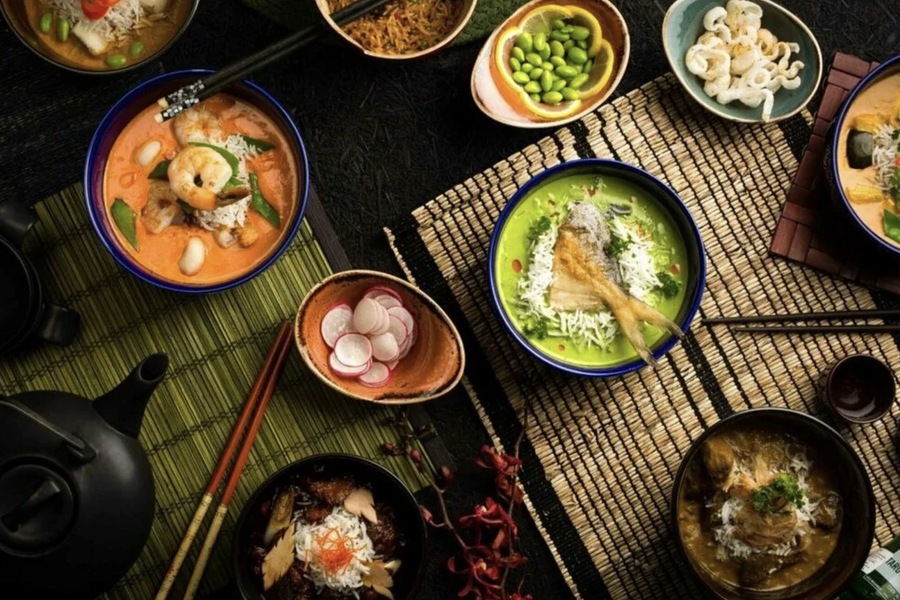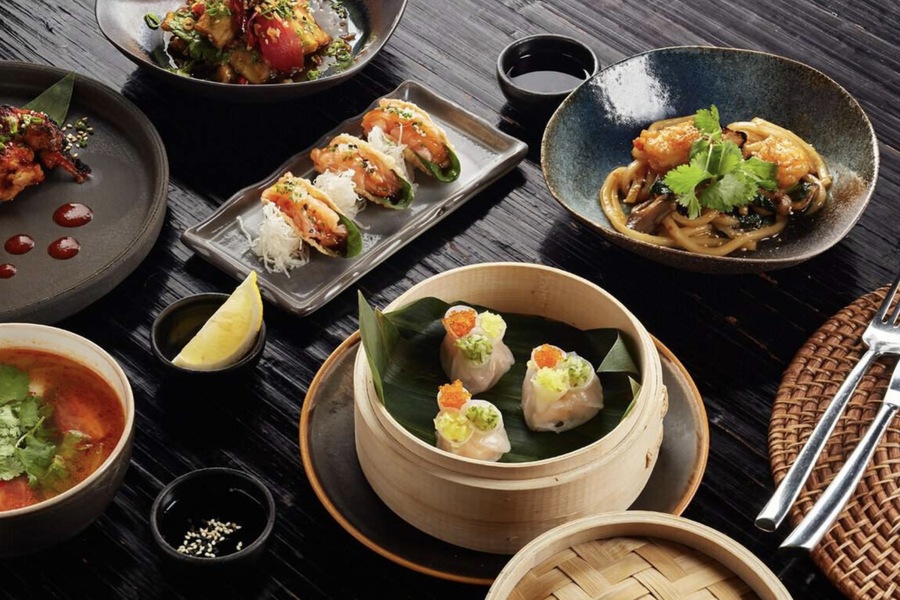Pan-Asian cuisine is a harmonious blend of gastronomic traditions from East, Southeast and South Asia. Drawing inspiration from countries such as Thailand, China, Japan, India, Singapore, Vietnam and Korea, it showcases an extraordinary diversity of flavours, ingredients and cooking techniques. The cuisine is renowned for its vibrant flavour profiles, emphasis on healthy eating and ability to seamlessly integrate diverse culinary influences. Over the years, Pan-Asian cuisine has transcended regional boundaries, gaining a worldwide fan base due to its unique ability to adapt to a variety of tastes and preferences. GreatList is your guide to Pan-Asian cuisine, featuring the best restaurants and cafes in Dubai serving these superb dishes.
The Global Popularity of Pan-Asian Cuisine
Pan-Asian cuisine is now embraced far beyond Asia, becoming a staple of global gastronomy. There are several reasons for its widespread popularity:
1. Emphasis on Healthy Eating
The focus on healthy eating is one of the key aspects that makes Pan-Asian cuisine so attractive, especially in a world where many are seeking balanced, nutritious meals. The cuisine places significant emphasis on the freshness and natural flavors of ingredients, ensuring that dishes are both wholesome and delicious. The common use of vegetables, lean proteins like seafood, tofu, and minimal use of processed ingredients aligns with modern dietary trends. Light soups, dishes cooked in steam, and the abundant use of herbs such as basil, mint, and cilantro make Pan-Asian cuisine particularly suited to individuals striving for a healthier lifestyle.
Additionally, the cooking methods themselves—stir-frying, steaming, and grilling—help preserve the nutritional value of ingredients. Pan-Asian dishes often feature low-fat cooking processes that retain the essential nutrients and flavors of the ingredients without adding excessive oils or fats. For health-conscious consumers, this makes Pan-Asian food a guilt-free indulgence.
2. The Appeal of Fusion Dishes
One of the most fascinating aspects of Pan-Asian cuisine is its adaptability to different culinary traditions. Modern chefs frequently experiment with Pan-Asian cuisine by creating fusion dishes that blend elements from multiple culinary traditions, not only from Asia but from around the world. For example, sushi tacos, a blend of Japanese sushi rolled in a crispy taco shell, or Thai-style pizza topped with traditional ingredients like basil and shrimp, are popular modern interpretations.
Fusion cuisine appeals to a broad audience and allows chefs to push the boundaries of traditional Pan-Asian dishes, creating unique and innovative offerings that attract food lovers from all over the world. It’s this blending of flavors and culinary philosophies that has turned Pan-Asian cuisine into a creative playground for gourmets and chefs alike.
3. Growing Interest in Asian Culture
Globalization and the rise of tourism have also contributed to the popularity of Pan-Asian cuisine. As more people travel to countries in East and Southeast Asia, they gain exposure to the rich cultural heritage and unique food traditions of these regions. Upon returning home, the memories of flavorful street food stalls in Bangkok or Tokyo’s bustling sushi bars create a demand for similar experiences in their local markets.
Cultural phenomena like Asian-themed food festivals, cooking shows, and social media platforms have also played a crucial role in spreading Pan-Asian cuisine’s appeal. Cooking classes and masterclasses, either in-person or virtual, allow home cooks to learn how to recreate iconic Pan-Asian dishes in their own kitchens. As a result, this exposure and growing familiarity with Asian culture has sparked a global craving for authentic Pan-Asian flavors.

Key Features of Pan-Asian Cuisine
Pan-Asian cuisine stands out for its unique approach to balancing flavors and creating an unforgettable dining experience. There are several defining characteristics that make Pan-Asian dishes a delight for the palate:
1. Bright and Layered Flavors
One of the most remarkable features of Pan-Asian cuisine is the way it incorporates a broad spectrum of flavors into each dish. Unlike Western cooking, where a dish may focus on one or two primary flavors, Pan-Asian cuisine often balances contrasting flavors such as sweet, salty, spicy, and sour all at once. The use of ingredients like lime juice, chili peppers, tamarind, fish sauce, and palm sugar gives dishes a complex, multi-layered taste.
For example, Thai cuisine is famous for its perfect blend of these flavor profiles, especially in dishes like Tom Yum soup or Pad Thai. The balance of sweet coconut milk, spicy chili paste, salty fish sauce, and sour lime juice is a signature of many Pan-Asian dishes.
2. Abundant Use of Sauces and Spices
Sauces and spices are central to Pan-Asian cuisine, as they add depth and elevate the flavors of even the simplest ingredients. Soy sauce, oyster sauce, teriyaki sauce, sweet chili sauce, and peanut sauce are commonly used across different countries. These sauces provide both flavor and texture, making each dish unique.
In addition to sauces, spices such as chili peppers, curry powder, ginger, turmeric, lemongrass, and star anise are used to enhance the overall taste of dishes. These spices not only contribute to the intensity of the flavors but also offer medicinal benefits, aligning with the traditional belief in food as medicine in many Asian cultures.
3. Seafood at the Forefront
Pan-Asian cuisine is known for its extensive use of seafood. In coastal regions like Japan, Thailand, and Vietnam, seafood is readily available and often forms the basis of many dishes. From sushi in Japan to Pho Bo in Vietnam, seafood plays an integral role in defining the taste and character of Pan-Asian dishes.
Moreover, the way seafood is prepared—whether raw, grilled, or stir-fried—varies greatly depending on the region. Japanese sushi and sashimi emphasize the freshness and purity of the fish, while Thai and Vietnamese dishes might incorporate seafood into broths, curries, or stir-fries, using bold spices and sauces to complement the natural flavors of shrimp, fish, or squid.
4. Rice and Noodles as Staples
Rice and noodles are the foundational elements of many Pan-Asian dishes. Rice, particularly jasmine rice, basmati rice, and sticky rice, serves as an accompaniment to main dishes in many parts of Asia. Noodles, on the other hand, offer a wide variety of textures and flavors depending on the type—whether it’s udon (wheat), soba (buckwheat), or rice noodles (funchoza).
Noodles are used in an array of dishes, from hearty stir-fries to light soups. Whether served cold with dipping sauces or hot with rich broths, noodles offer a comforting base that allows the bolder flavors of the toppings to shine.
5. Minimal Cooking Time
In Pan-Asian cuisine, the goal is to cook ingredients as quickly as possible to retain their natural flavors and textures. Stir-frying in a wok, which is popular in Chinese, Thai, and Vietnamese cooking, allows ingredients to be rapidly cooked at high heat, ensuring that they are cooked through without losing their nutritional value.
This focus on minimal cooking time is not only convenient for fast-paced kitchens but also aligns with modern-day preferences for meals that are fresh, healthy, and quick to prepare.
6. Harmony of Flavors
The fundamental principle of Pan-Asian cuisine is balance. The contrast and interplay of sweet, salty, sour, bitter, and spicy flavors is carefully curated in each dish. This harmony is achieved through the thoughtful combination of ingredients and seasonings, such as balancing the sweetness of palm sugar with the saltiness of fish sauce or the bitterness of bitter melon with the richness of coconut milk.
In dishes like Tom Yum soup, for instance, the sourness of lime is offset by the sweetness of coconut milk and the heat from chili peppers, creating a perfect flavor harmony that is both refreshing and warming.
7. Cross-Cultural Influences
Pan-Asian cuisine draws influences from various culinary traditions across the region. The Japanese concept of “umami” (the fifth taste) is often incorporated into dishes from other countries. The Chinese mastery of wok-frying has influenced stir-frying techniques in Thai and Vietnamese cuisine. Thai dishes are known for their spiciness, while Vietnamese cuisine is celebrated for its use of fresh herbs like mint and cilantro.
This blend of culinary traditions creates an evolving cuisine that is constantly being redefined, making Pan-Asian food a fusion of cultures that caters to the adventurous palate.
8. Diverse Cooking Techniques
Pan-Asian cuisine employs a variety of cooking techniques that enhance both flavor and texture. Stir-frying, steaming, grilling, and fermentation are some of the common methods used. These techniques are not only practical but also help preserve the freshness and nutritional value of the ingredients.
For example, dim sum is traditionally steamed, while Korean BBQ involves grilling marinated meats over an open flame. Fermentation plays a crucial role in creating dishes like kimchi, which involves preserving vegetables with spices over a period of time, resulting in bold, tangy flavors.

Signature Dishes of Pan-Asian Cuisine
Pan-Asian cuisine is known for an array of iconic dishes that have made their mark globally. Some of the most beloved dishes include:
Tom Yum
A Thai soup that features a rich broth made with coconut milk, seafood, and mushrooms. Its unique flavor profile comes from ingredients such as lemongrass, galangal root, mint leaves, and chili paste.
Pho Bo
A Vietnamese noodle soup with a flavorful beef broth. Thin slices of raw beef are added to the hot broth, cooking the meat just before it’s served.
Pad Thai
A famous Thai stir-fried noodle dish that includes shrimp, chicken, tofu, peanuts, and eggs. It is a perfect blend of sweet, sour, and spicy flavors.
Dim Sum
Small Chinese pastries or dumplings that are filled with a variety of ingredients such as vegetables, seafood, or meat. They are usually steamed, fried, or baked.
Bibimbap
A traditional Korean rice bowl served with a variety of vegetables, meat, and a fried egg on top, all mixed together with spicy gochujang sauce.
Go Hiong
A Chinese dish of fried spring rolls filled with shrimp, pork, and vegetables.
Seafood Udon
A Japanese dish featuring wheat noodles served with a mix of seafood and oyster sauce for a salty-sweet taste experience.
Kimchi
A staple in Korean cuisine, this fermented cabbage dish is known for its spicy and tangy flavor and is packed with probiotics.
Exploring Pan-Asian Cuisine in Dubai with GreatList
For those in Dubai eager to explore the world of Pan-Asian flavors, GreatList offers an exceptional guide to the best dining establishments in the city. Whether you’re craving authentic Thai street food, a steaming bowl of Vietnamese pho, or a modern fusion dish, GreatList’s team of experts has tasted and reviewed a wide range of eateries. The platform provides truthful reviews and recommendations on everything from casual cafes to upscale restaurants. With GreatList, you’ll have access to the best Pan-Asian dining experiences in Dubai, helping you discover both traditional and innovative dishes.
Visit GreatList to embark on your culinary journey through the rich and flavorful world of Pan-Asian cuisine today.

